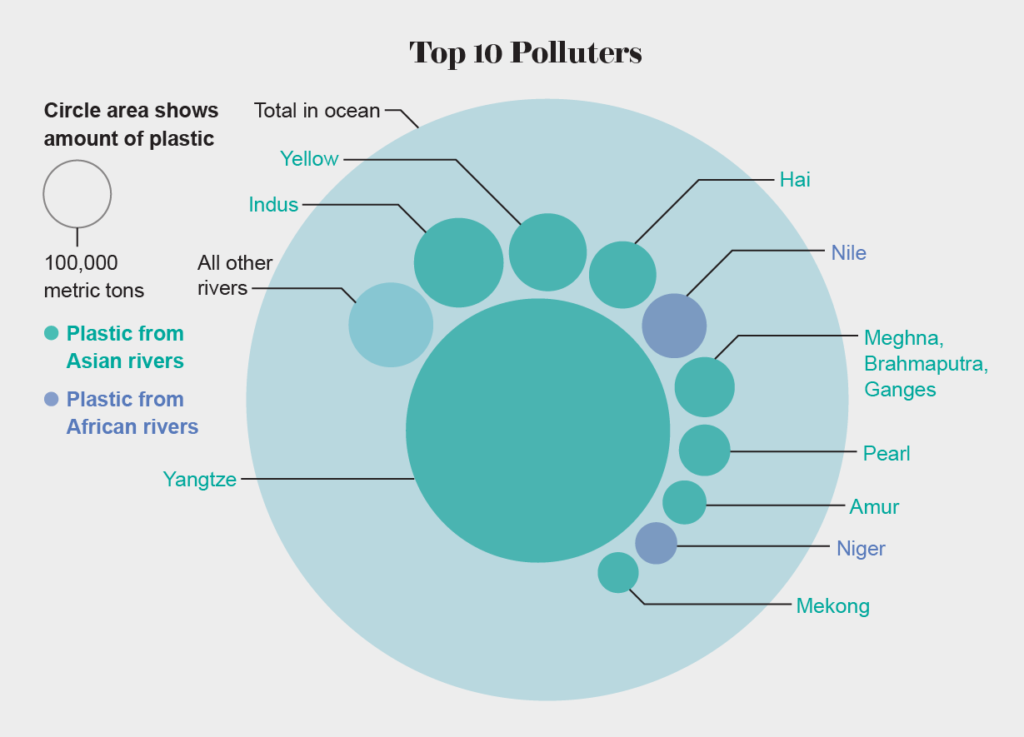Stemming the Plastic Tide: 10 Rivers Contribute Most of the Plastic in the Oceans
ENVIRONMENT, 19 Feb 2018
Prachi Patel | Scientific American – TRANSCEND Media Service
The Yangtze alone pours up to an estimated 1.5 million metric tons into the Yellow Sea.
1 Feb 2018 – Our seas are choking on plastic. A staggering eight million metric tons wind up in oceans every year, and unraveling exactly how it gets there is critical. A recent study estimates that more than a quarter of all that waste could be pouring in from just 10 rivers, eight of them in Asia.
“Rivers carry trash over long distances and connect nearly all land surfaces with the oceans,” making them a major battleground in the fight against sea pollution, explains Christian Schmidt, a hydrogeologist at the Helmholtz Center for Environmental Research in Leipzig, Germany.
Schmidt and his colleagues dug up published data on the plastic concentration in 57 rivers of various sizes around the world. These measurements included bottles and bags, as well as microscopic fibers and beads. The researchers multiplied these concentrations by the rivers’ water discharge to calculate the total weight of plastic flowing into the sea. They then fed these data into a model that compared them with the estimated weight of plastic litter generated per person per day along each river.
The results, published last November in Environmental Science & Technology, show that rivers collectively dump anywhere from 0.47 million to 2.75 million metric tons of plastic into the seas every year, depending on the data used in the models. The 10 rivers that carry 93 percent of that trash are the Yangtze, Yellow, Hai, Pearl, Amur, Mekong, Indus and Ganges Delta in Asia, and the Niger and Nile in Africa. The Yangtze alone dumps up to an estimated 1.5 million metric tons of plastic waste into the Yellow Sea.
Better waste collection and management practices in the most polluted regions would help stem the tide, Schmidt says, but raising public awareness is also crucial.
____________________________________
This article was originally published with the title “Rivers of Plastic”
Go to Original – scientificamerican.com
DISCLAIMER: The statements, views and opinions expressed in pieces republished here are solely those of the authors and do not necessarily represent those of TMS. In accordance with title 17 U.S.C. section 107, this material is distributed without profit to those who have expressed a prior interest in receiving the included information for research and educational purposes. TMS has no affiliation whatsoever with the originator of this article nor is TMS endorsed or sponsored by the originator. “GO TO ORIGINAL” links are provided as a convenience to our readers and allow for verification of authenticity. However, as originating pages are often updated by their originating host sites, the versions posted may not match the versions our readers view when clicking the “GO TO ORIGINAL” links. This site contains copyrighted material the use of which has not always been specifically authorized by the copyright owner. We are making such material available in our efforts to advance understanding of environmental, political, human rights, economic, democracy, scientific, and social justice issues, etc. We believe this constitutes a ‘fair use’ of any such copyrighted material as provided for in section 107 of the US Copyright Law. In accordance with Title 17 U.S.C. Section 107, the material on this site is distributed without profit to those who have expressed a prior interest in receiving the included information for research and educational purposes. For more information go to: http://www.law.cornell.edu/uscode/17/107.shtml. If you wish to use copyrighted material from this site for purposes of your own that go beyond ‘fair use’, you must obtain permission from the copyright owner.
